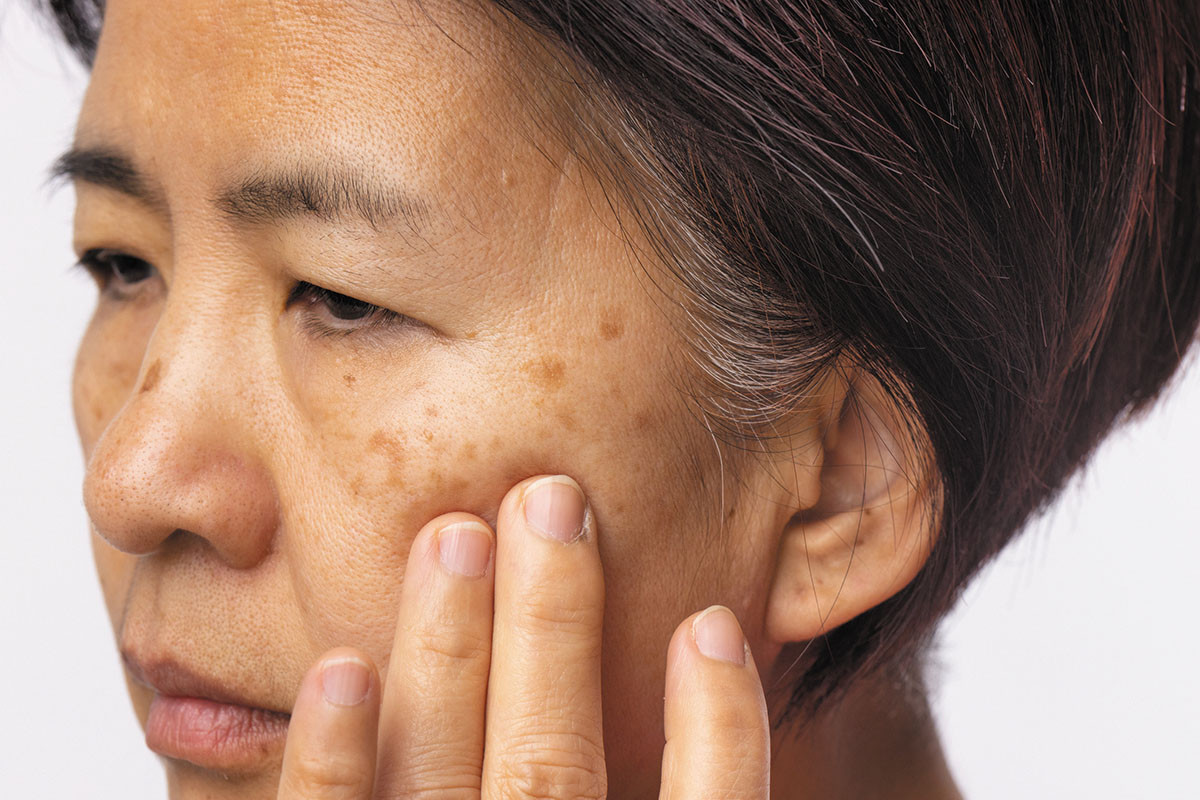A mask that's hard to shed
Despite its nickname as the "mask of pregnancy," melasma can strike throughout the years.
- Reviewed by Toni Golen, MD, Editor in Chief, Harvard Women's Health Watch; Editorial Advisory Board Member, Harvard Health Publishing; Contributor

Since the start of the pandemic, many of us have contemplated the pros and cons of masks. Yet there's another type of mask that's been around for a long time but isn't as easy to peel off. It's called melasma, and 90% of its sufferers are women, according to the American Academy of Dermatology.
Melasma is often dubbed the "mask of pregnancy" because its characteristic dark patches — which tend to cluster on the nose, cheekbones, and jaw — are even more prevalent in expectant mothers. But hormonal fluctuations related to birth control pills, menopause, and hormone therapy are also triggers, says Dr. Arianne Shadi Kourosh, director of the Pigmentary Disorder and Multiethnic Skin Clinic at Harvard-affiliated Massachusetts General Hospital.
Melasma isn't harmful, but its stubborn splotches (known formally as hyperpigmentation) can certainly lead to emotional distress, Dr. Kourosh says. And some melasma is so severe it can't be covered with makeup. "Patients have told me their melasma is ruining their life," she says. "Some isolate themselves and don't want to go out in public because they feel so disfigured."
Insight into triggers
Hormonal ups and downs work hand in hand with other factors, including genetics and darker skin tones, to make melasma more likely. But the chief co-conspirator is sun exposure. In recent years, scientists have also learned that ultraviolet (UV) light from the sun isn't the only offender, with blue light from screens and devices also contributing to melasma development. Even prolonged heat exposure (say, from standing near an oven) or air pollution (such as smog and car exhaust) can play a part.
"These harmful chemicals and pollution can corrode the skin's protective barrier and cause irritation that worsens hyperpigmentation," Dr. Kourosh says.
Certain medications, including some antibiotics and pain remedies, can also make us more sensitive to light exposure and aggravate melasma. That's why Dr. Kourosh thoroughly reviews a patient's medical history when she diagnoses melasma, a process sometimes aided by devices that measure how deeply pigment is deposited within the skin.
"It's really a holistic picture," she says. "I need to rule out other problems that can cause hyperpigmentation, including hormonal imbalances, medication reactions, or endocrine disorders."
Tips to prevent flare-upsMelasma can easily come back despite vigorous treatment, but you can stave off that scenario with these measures. Use sunscreen daily. Choose one with broad-spectrum protection, labeled SPF 30 or higher. Even better, mineral-based sunblocks shield your skin from all visible light along with UV rays. Wear a broad-brimmed hat. "A multilayered approach to sun protection can make the difference in terms of people whose melasma gets better and those who don't," says Dr. Arianne Shadi Kourosh, a dermatologist at Massachusetts General Hospital. Practice gentle skin care. Melasma can't just be scrubbed off, and ironically, skin-cleansing products may irritate and worsen it. Stay clear of products that sting or burn, and avoid harsh hair-removal efforts, such as waxing. |
Mainstays and new approaches
Melasma can fade or disappear on its own, especially when the trigger causing it — such as a sunshine-filled vacation, pregnancy, or oral contraceptive use — ends. But you shouldn't try to self-diagnose or treat melasma without a dermatologist's input, Dr. Kourosh says. If you're tempted to use a nonprescription product that claims to lighten dark patches, you need a doctor's expertise on its safety and effectiveness.
That said, various mainstay treatments and newer remedies are available. Options your doctor may recommend include the following:
Hydroquinone. This skin-lightening substance comes in cream, lotion, gel, or liquid form. It works by destroying overly pigmented skin cells.
Tretinoin and corticosteroids. Tretinoin is a retinol derived from vitamin A that boosts cell turnover in skin, enhancing skin lightening when added to hydroquinone. Steroids can lower skin inflammation. A "triple cream" (Tri-Luma) may contain all three substances.
Acid-based lighteners. Incorporating azelaic acid, kojic acid, or other acids, these topical products gently slough off top skin layers to reduce dark patches.
Tranexamic acid. Traditionally used to treat heavy bleeding, this medication has also proven effective in recent years against stubborn melasma, Dr. Kourosh says. But the pandemic dialed back its use somewhat, because one possible side effect — blood clots — is also a complication of COVID-19.
Dr. Kourosh also red-flags chemical peels or laser procedures to treat melasma. Many "medical spas" advertise these techniques to lighten splotchy skin, but they're often staffed by workers without medical training who can't ensure results. "These procedures can do more harm than good by heating and inflaming the skin," she says.
Image: © Toa55/Getty Images
About the Author

Maureen Salamon, Executive Editor, Harvard Women's Health Watch
About the Reviewer

Toni Golen, MD, Editor in Chief, Harvard Women's Health Watch; Editorial Advisory Board Member, Harvard Health Publishing; Contributor
Disclaimer:
As a service to our readers, Harvard Health Publishing provides access to our library of archived content. Please note the date of last review or update on all articles.
No content on this site, regardless of date, should ever be used as a substitute for direct medical advice from your doctor or other qualified clinician.
















